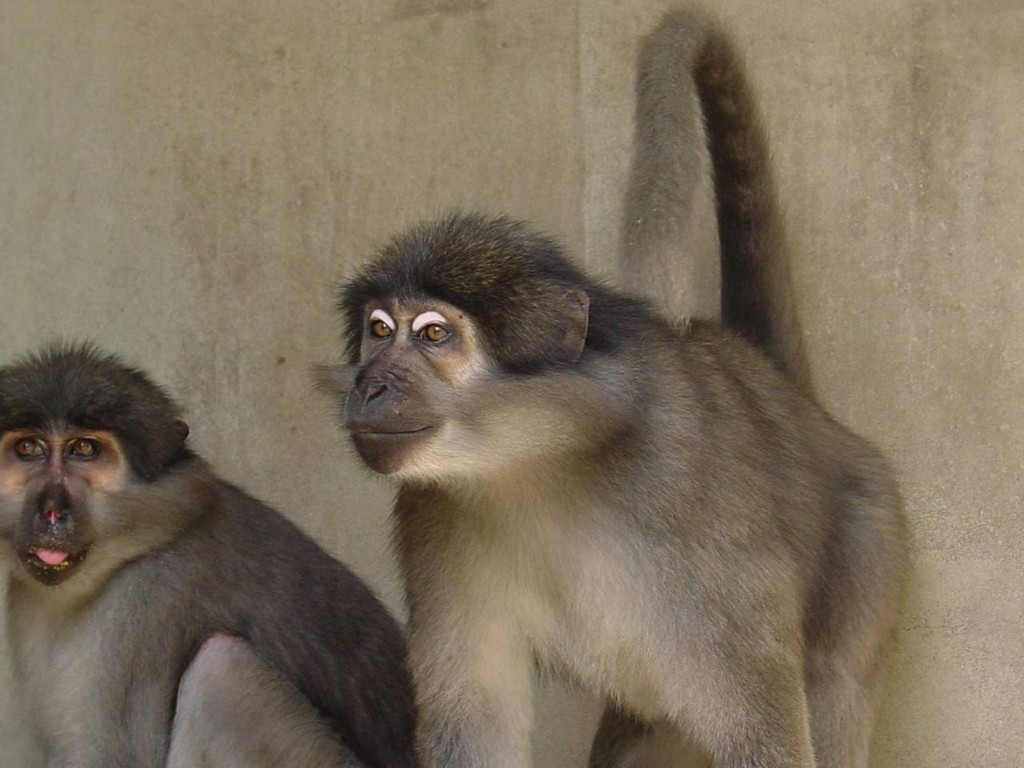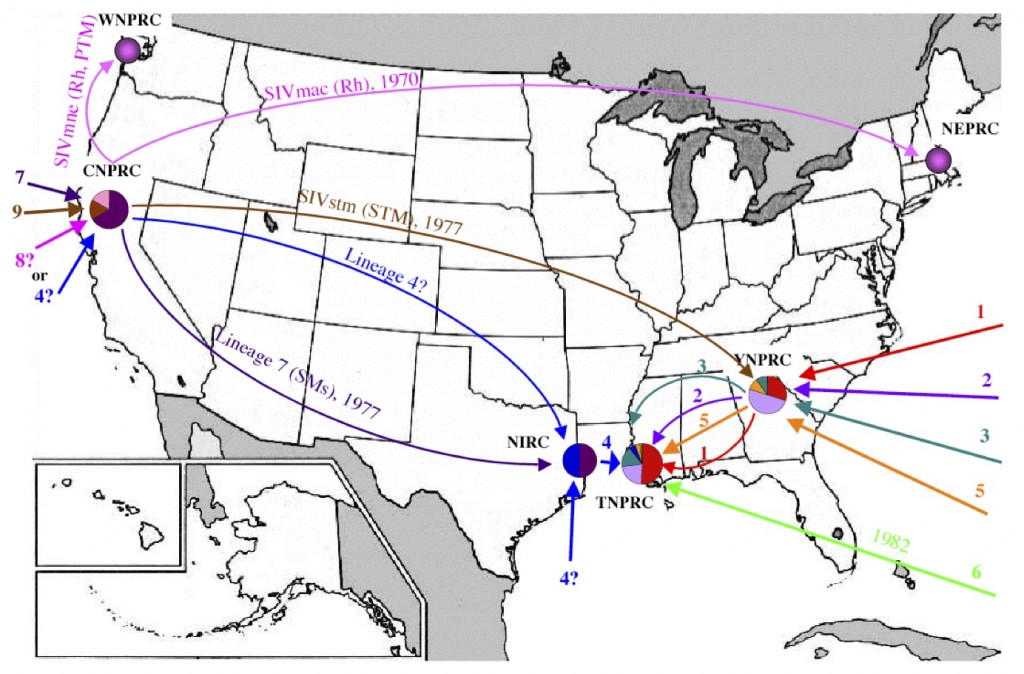 Here’s a mystery story. Characters include: monkeys, a genius-cum-child molester, an obsessive virologist, and a lot of really scary diseases. Oh and animal models.
Here’s a mystery story. Characters include: monkeys, a genius-cum-child molester, an obsessive virologist, and a lot of really scary diseases. Oh and animal models.
In the mid-1980s, monkeys at the New England Primate Research Center began to die. The disease struck only a handful of rhesus macaques – monkeys from Asia that have bald, pink faces and resemble grizzled old men – and would likely have escaped notice were it not for the symptoms: cancers and opportunistic infections that strike only those with compromised immune symptoms. The monkeys, in plain speak, were dying of AIDS.By that point it was known that an immunodeficiency virus (HIV) caused AIDS in humans. Beyond that, the disease remained enigmatic: Where had it come from? What made it so deadly? And was a cure possible? Barred from testing experimental drugs and invasive procedures on people, researchers were racing to find a suitable animal – called an “animal model” — to jab and prod instead. The disease that causes AIDS in macaques was named SIVmac. Today, a cure for AIDS may well be found in a macaque.
The story could end here. But SIVmac left some niggling questions. Just as HIV researchers wondered – and continue to wonder in an acrimonious sort of way – how HIV burst into an epidemic, monkey folks began to wonder the same about SIV. How did the disease emerge in New England? Did SIV really mirror HIV? More than mere curiosity, tracing the history of a disease’s origins provides clues about where epidemics come from and, potentially, how to give them a wide berth in the future.
 Enter leprosy and Louise. Louise was a sooty mangabey, a type of monkey from Africa with (surprise) fur the color of soot. Until Louise, it was believed that leprosy only afflicted humans. But Louise clearly had a “leprosy-like disease,” recounts Bobby Gormus, an immunologist then at the Tulane National Primate Research Center in Louisiana. Louise eventually passed leprosy onto her cage mate. Excited by the possibility of a primate model for leprosy, Gormus transplanted leprotic tissue from mangabeys into more readily available macaques. The macaques developed leprosy and … AIDS. A study appeared in Nature in 1986 with the title “Isolation of an HTLV-III-related retrovirus from macaques with simian AIDS and its possible origin in asymptomatic mangabeys.” That means mangabeys carry SIV without symptoms. Macaques don’t carry SIV and lack immunity to it. Put simply: Mangabeys give macaques AIDS. Buggers.
Enter leprosy and Louise. Louise was a sooty mangabey, a type of monkey from Africa with (surprise) fur the color of soot. Until Louise, it was believed that leprosy only afflicted humans. But Louise clearly had a “leprosy-like disease,” recounts Bobby Gormus, an immunologist then at the Tulane National Primate Research Center in Louisiana. Louise eventually passed leprosy onto her cage mate. Excited by the possibility of a primate model for leprosy, Gormus transplanted leprotic tissue from mangabeys into more readily available macaques. The macaques developed leprosy and … AIDS. A study appeared in Nature in 1986 with the title “Isolation of an HTLV-III-related retrovirus from macaques with simian AIDS and its possible origin in asymptomatic mangabeys.” That means mangabeys carry SIV without symptoms. Macaques don’t carry SIV and lack immunity to it. Put simply: Mangabeys give macaques AIDS. Buggers.
The mangabey disease was named SIVsm. It all would have made perfect sense, except for one small problem. In the 1980s, the primate center in New England didn’t have any mangabeys.
Cristian Apetrei is a virologist now at the University of Pittsburgh in Pennsylvania. He did not set out to find the source of monkey AIDS. Instead, Apetrei was worried that SIV might not be a good model to study HIV. HIV is a complex virus. It evolves quickly and has numerous variants. To create a vaccine against HIV, researchers need to inoculate against all those variants. But with pathogenic SIV limited to macaques in research labs, Apetrei feared that the virus lacked genetic diversity. That meant that a vaccine might very well succeed in monkeys but fail in humans. To see how SIV evolved and mutated, Apetrei began using phylogenetic analysis to trace the spread of monkey AIDS.
 His research traced SIV’s epicenter to California. It was known, says Apetrei, that monkeys at the California National Primate Research Center got hit with a mystery illness in the 1970s. AIDS had yet to be discovered so the disease went into the annals of history and the deceased monkeys into cold storage. Monkeys that survived the outbreak, however, went elsewhere. “The rhesus survivors were exported to the New England Primate [Research] Center. The stump-tailed survivors were exported to Yerkes … Meanwhile Yerkes had its own colony and in their colony they had different strains that circulated which were probably directly imported from Africa. California had its own colony and had sooty mangabeys strains imported from Africa. New Iberia got monkeys from California so they have the same strain as California. And Tulane got the monkeys from New Iberia and Yerkes so the strains at Tulane are Yerkes and Iberia,” Apetrei explains. “It gets very confusing.”
His research traced SIV’s epicenter to California. It was known, says Apetrei, that monkeys at the California National Primate Research Center got hit with a mystery illness in the 1970s. AIDS had yet to be discovered so the disease went into the annals of history and the deceased monkeys into cold storage. Monkeys that survived the outbreak, however, went elsewhere. “The rhesus survivors were exported to the New England Primate [Research] Center. The stump-tailed survivors were exported to Yerkes … Meanwhile Yerkes had its own colony and in their colony they had different strains that circulated which were probably directly imported from Africa. California had its own colony and had sooty mangabeys strains imported from Africa. New Iberia got monkeys from California so they have the same strain as California. And Tulane got the monkeys from New Iberia and Yerkes so the strains at Tulane are Yerkes and Iberia,” Apetrei explains. “It gets very confusing.”
Perversely, all that monkey mingling meant that HIV and SIV had a lot in common. Just as HIV spread from a handful of individuals into the West – most notoriously from Gaëtan Dugas who claims to have had sex with 2,500 people – pathogenic SIV spread from a handful of monkeys. Monkey and human immunodeficiency viruses, Apetrei concluded, were equally bastardized.
By now, Apetrei was in deep. If, he wondered, SIV got to New England from California, how did it get to California? He knew that SIV becomes lethal when it migrates from mangabeys to macaques. And he knew that mangabeys were carriers of SIV. Who, he wanted to know, was conducting research on mangabeys in California in the 1970s?
He found Nobel laureate D. Carleton Gajdusek. Gajdusek is famous for his research into kuru, a brain-wasting disease prevalent among members of the Fore tribe in New Guinea. That work set the stage for understanding diseases caused by misfolded proteins, or prions. In the 1970s, Gajdusek was a virologist at the California primate center working to create an animal model for kuru (animal models figure prominently in this tale). So he transplanted infected brain tissues from mangabeys into macaques – the same experiment that Bobby Gormus unwittingly replicated a decade later.
Apetrei sent his counterparts in California into the research center’s freezers to see if they could scrounge up four-decade-old mangabeys. They did. Sure enough, those monkeys carried the founding strains for SIV, including, at last, the strain that killed off those ill-fated macaques in New England. In 2006, Apetrei was the lead author on a study with the straightforward title: “Kuru experiments triggered the outbreak of pathogenic SIVmac.”
Lest anyone think Apetrei was less than thorough, a final tidbit: With evidence mounting that Gajdusek spearheaded a monkey epidemic, Apetrei tried to reach him for comment. Besides winning a Nobel, Gajdusek is famous, or really infamous, for returning from New Guinea with scores of underage children, mostly boys. In 1997, Gajdusek was jailed for child molestation. After serving his sentence, Gajdusek disappeared in Europe. A savvy technician in Apetrei’s lab scoured 25 European phone books and found Gajdusek’s number in Amsterdam. But Gajdusek, who died in 2008, never returned Apetrei’s calls. Nonetheless, to his posthumous plaudits Gajdusek can now add creator of monkey epidemic. If research on the macaque model for SIV bears out, Gajdusek may also emerge as the man who made possible a cure for AIDS.
__________
Sujata Gupta is a freelance science writer based in Burlington, Vermont. She writes about the environment and health and often the intersection of the two. More info and clips can be found at www.sujatagupta.com.
Photo credits: rhesus macaque – Thomas Schoch, Wikimedia Commons; sooty mangabey & lineage map – Robin Rodrigues, Tulane National Primate Research Center
Very interesting. Great job.